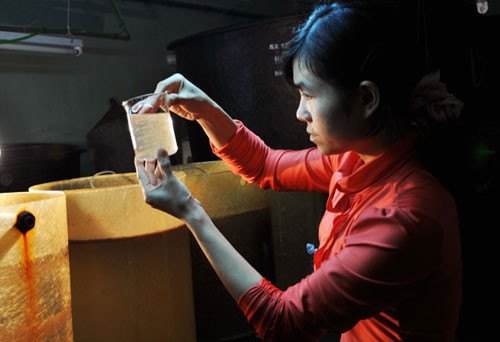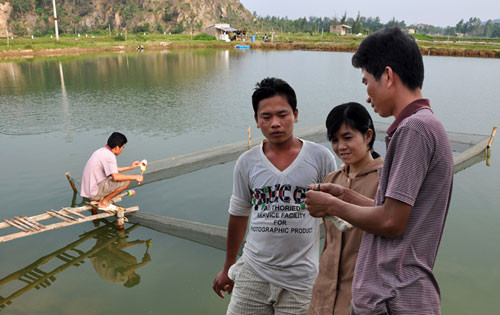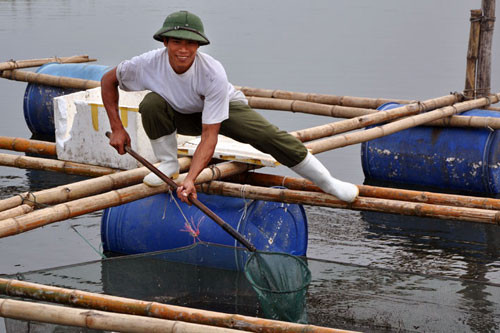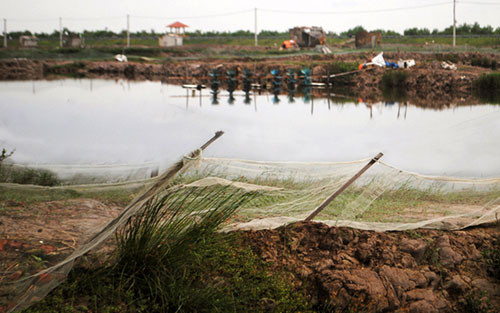Lesson II: Wishes and Concerns
The project of raising goby fish in brackish water ponds in Nghe An by Engineer Nguyen Thi Le Thuy has completed phase 1. With an average yield of 10 tons/ha/year, it has affirmed the economic efficiency of this livestock species. However, to replicate the model into a specialized commercial fish farming area, to make goby fish become a specialty of Nghe An is still a long story...
(Baonghean) -The project of raising goby fish in brackish water ponds in Nghe An by Engineer Nguyen Thi Le Thuy has completed phase 1. With an average yield of 10 tons/ha/year, it has affirmed the economic efficiency of this livestock species. However, to replicate the model into a specialized commercial fish farming area, to make goby fish become a specialty of Nghe An is still a long story...
Returning the plastic basin filled with jet-black goby fish to engineer Le Duy Tan, after a while of struggling until they were tired and lying still, I happily let myself drift in the cool afternoon breeze. The entire aquaculture pond here is lush green, the water is clear and calm, the pond banks are also green with trees and grass. However, this is not the pond of the newly implemented project!
I asked, Engineer Nguyen Thi Le Thuy explained: Yes, that's right, the location that the Project chose to pilot commercial goby farming is in Hung Hoa commune (Vinh city), not here, Nghi Hop commune.
The project "Application of scientific and technological advances to build a model of goby farming in brackish water ponds in Vinh City" chose Hung Hoa commune because it is only 5km from Vinh city center, convenient for transportation. The whole commune has a total brackish water farming area of 130 hectares (mainly shrimp farming area), the brackish water field here is surrounded by a 2km long dike system, with a bottom of mud and sand, mud sand; fresh water from Lam River and salt water when the tide rises form brackish water with salinity ranging from 15 - 25‰, very suitable for the growth and development of goby.

KS Nguyen Thi Le Thuy monitors the development of larvae at the North Central Aquaculture Research Institute.
Aquaculture engineers check the quality of fish fry raised in outdoor ponds.
Nghi Hop commune.
In 2010, the Project selected 2 households in Phong Yen hamlet: Mr. Nguyen Van Tuan (raising area: 2,500m2) and Mr. Luu Hong Huong (farming area is 2,500m2), the total area of the two households is 5,000m2After 6 months of farming, pond 1 harvested 2,801 kg, pond 2 harvested 2,920 kg, the total harvest reached 5,721 kg/0.5 ha, an average of over 11 tons/ha. According to the acceptance council's assessment, the growth rate of the goby fish as above is good, the weight of the fish achieved is higher than in the Thanh Hoa farming area and the fish yield is equivalent to the Nghia Hung - Nam Dinh farming area (10-11 tons/ha). Fish harvested at this size are easy to consume and the product price is high.
In 2011, some shrimp ponds of the people of Hung Hoa commune and the pilot goby pond area of the project were included in the planning of the eco-tourism area, so many households stopped raising shrimp. Two households selected to raise goby also stopped investing, so the project had to move to Nghi Hop commune.
KS. Thuy said: This is an old shrimp pond of Nghi Hop commune. Last year, there was a storm and flood, the water level was more than 1 meter high, the protective net was also swept away by duckweed and trash, all the shrimp were lost, most of the people gave up because of lack of capital and strength. We, the brothers and sisters in the Institute, pooled some money to rent some ponds to continue the project. Although farming here is very difficult, all the infrastructure and environmental conditions are not as good as in Hung Hoa commune, we are still successful.
Mr. Thuy also added: Some households in Hung Hoa saw that raising goby fish was effective and switched to investing in raising them in Nghi Xuan district (Ha Tinh). Many other provinces have also successfully raised this type of fish. For example, in Nga Son district (Thanh Hoa), after one year of raising goby fish, they earned 300 million VND/ha, in Nghia Hung district (Nam Dinh), they earned 780 million VND/ha. In Hai Phong, since 2006, farmers in Vinh Bao, Tien Lang, Do Son, and Cat Hai have switched from raising shrimp with unstable prices and many diseases to raising goby fish, which brings high economic benefits, contributes to creating jobs for many workers, and effectively uses brackish water pond areas for ineffective shrimp farming.

Mr. Hoi catches commercial goby fish in Nghi Hop pond for reporters to see.
Shrimp pond in Hung Hoa commune is part of an eco-tourism project so it is not
well taken care of by the owner.
In Nghe An, only a few households in Quynh Luu raise goby fish in small ponds, there is no large-scale commercial goby fish farming model. Many households have been raising whiteleg shrimp and tiger prawns, but the farming techniques require strict and strict requirements, and diseases often occur, leading to losses, but they have not found any alternative livestock.
The project of raising goby fish in brackish water ponds in Nghe An by Engineer Nguyen Thi Le Thuy has completed phase 1, affirming the success of the model from the stage of raising fingerlings to fingerlings and the effectiveness of the model from fingerlings to commercial fish, with a productivity of 10 tons/ha/year.
I asked about phase 2 of the project - Expanding the model into a specialized commercial fish farming area, engineer Le Duy Tan lowered his voice: "Raising goby fish is easier than raising shrimp, because they are very strong, adaptable to the environment, have few diseases but still bring high economic efficiency. However, to expand the model into a specialized commercial fish farming area, to make goby fish become a specialty of Nghe An is still too difficult, sir!"
The concerns and wishes of aquatic engineers must be a long story…
Minh Thong
